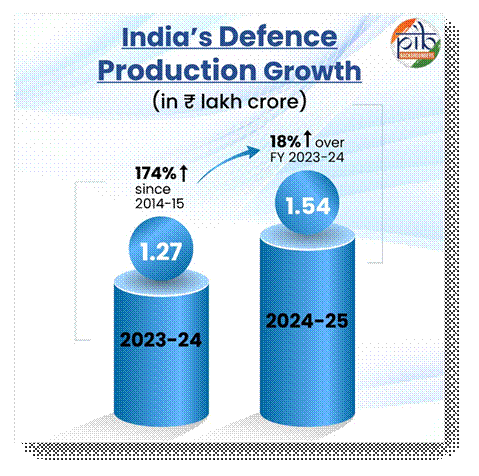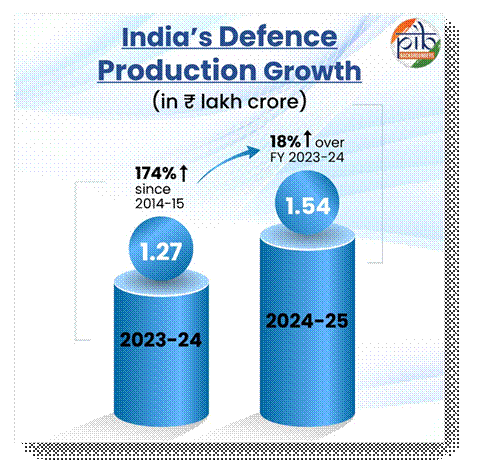#DefenceAtmanirbharta #MakeInIndiaDefence #RecordExports #IndianDefence #MSME #DPEPP #DefenceProduction #GlobalDefenceHub #Indigenisation
- India recorded its highest-ever defence production of ₹1.54 lakh crore in FY 2024 25
- Indigenous defence production hit a record ₹1,27,434 crore in FY 2023-24, a 174% surge from ₹46,429 crore in 2014-15
- 16,000 MSMEs are emerging as the game-changers, strengthening indigenous defence capabilities
- 788 industrial licenses have been issued to 462 companies.
- India s defence exports reached a record ₹23,622 crore in FY 2024 25 from less than ₹1,000 crore in 2014.
PIB Delhi
New Delhi: India’s indigenous defence production hit a record ₹1,27,434 crore in FY 2023-24, a 174% surge from ₹46,429 crore in 2014-15, fueled by Prime Minister Shri Narendra Modi’s Atmanirbharta policies. The upward trajectory in defence production is the result of continued government support over the past decade in the form of huge allocation and policy level support extended to India s military industrial base. The rise in the defence budget, from ₹2.53 lakh crore in 2013-14 to ₹6.81 lakh crore in 2025-26, underlines the government s determination to strengthen country s military infrastructure. In order to reduce dependency on foreign countries, both public and private segments of the industry have demonstrated consistent year-on-year growth, attributed to far-reaching policy reforms, enhanced ease of doing business, and a strategic focus on indigenisation over the past decade. India now exports to over 100 nations, including to United States, France and Armenia. Defence Public Sector Undertakings (DPSUs) and other PSUs accounted for approx. 77% of total production, while the private sector contributed 23%. The share of the private sector, which increased from 21% in FY 2023-24 to 23% in FY 2024-25, reflects the sector’s growing role in the defence ecosystem of the country. As a result, exports too saw a growth of Rs 2,539 crore or 12.04% over the exports figures of FY 2023-24. The government aims to achieve defence manufacturing worth Rs. 3 lakh crore and ₹50,000 crore in defence exports by 2029, reinforcing India’s role as a global defence manufacturing hub while boosting economic growth. Therefore, India’s defence production sector is poised for continued acceleration in the years ahead, making the country Atmanirbhar.

Boosting defence exports with simplified licensing, covering platforms such as bulletproof jackets, Dornier aircraft, Chetak Helicopters, and fast interceptor boats, and lightweight torpedoes.
Declared as the Year of Reforms in 2025, the initiatives aim to transform the Armed Forces into a technologically advanced, combat-ready force capable of multi-domain integrated operations, while expanding defence production to ₹3 lakh crore and achieving export targets of ₹50,000 crore by 2029.

2. Defence Industrial Corridors – The New Growth Arteries:
Two corridors, Uttar Pradesh Defence Industrial Corridor (UPDIC) and Tamil Nadu Defence Industrial Corridor (TNDIC), are the lifelines of this transformation. Together, they have attracted investments worth over ₹9,145 crore, with 289 MoUs signed, unlocking ₹66,423 crore in potential opportunities, as of October 2025.
3. Expanding the Defence Ecosystem:
DRDO has become a frontline institution that is driving India s defence revolution. Raksha Mantri Shri Rajnath Singh grant has approved a Corpus of Rs 500 crore to cater for deep-tech and cutting-edge projects as separate verticals under Technology Development Fund (TDF) scheme, Technology Transfers, and 15 Defence Industry-Academia Centres of Excellence (DIA-CoEs), it is directly linking academia, start-ups, and industries in defence innovation. The restructuring of Ordnance Factories and creation of seven defence companies, was undertaken to enhance functional autonomy, improve efficiency, and increase self-reliance in the defence preparedness of the country. The private sector is no longer a silent observer. From drones to avionics to cutting-edge electronics, companies both big and small are stepping up, while 16,000 MSMEs are emerging as the game-changers, proving that India s defence manufacturing is no longer just about the giants, it s an ecosystem where every innovator has a role to play.
4. Opening New Horizons – Investment Opportunities:
India has emerged as one of the most attractive destinations for defence investment. With 788 industrial licenses issued to 462 companies, the participation of Indian industry in defence manufacturing is growing rapidly. The Department of Defence Production has streamlined business through a fully digital portal for export authorizations, leading to 1,762 approvals in FY 2024 25, compared to 1,507 in FY 2023-24, marking a 16.92% year-on-year growth and a 17.4% increase in the number of exporters. Combined with liberalized FDI norms, the PLI scheme, and modern defence corridors, India offers a compelling opportunity for both domestic innovators and global investors.
In 2024-25, the Ministry of Defence signed a record 193 contracts valued at ₹2,09,050 crore, marking the highest ever in a single financial year. Of these, 177 contracts, worth ₹1,68,922 crore, were awarded to the domestic industry, reflecting a decisive shift toward Indian manufacturers and a strengthened indigenous defence ecosystem. This emphasis on local procurement has also spurred employment generation and technological innovation across the sector.
Rising Acquisition Budget and Decadal Growth
The Defence Acquisition Council (DAC), chaired by the Raksha Mantri, has approved record volumes of indigenous procurements in recent years. Modernisation and indigenization of the Armed Forces remain a key priority of the Government. In the Union Budget 2024-25, an allocation of ₹1.72 lakh crore has been made under the Capital Head for the Defence Services, reflecting a 20.33% increase over the actual expenditure of FY 2022-23 and a 9.40% compared to the Revised Estimates of FY 2023-24.
In August 2025, the DAC approved proposals worth ₹67,000 crore to enhance the operational capabilities of the Armed Forces. Key approvals included Thermal Imager-based Night Sights for BMPs for the Army, Compact Autonomous Surface Craft, BrahMos Fire Control Systems, and BARAK-1 upgrades for the Navy, and Mountain Radars along with SAKSHAM/SPYDER upgrades for the Air Force. The DAC also cleared indigenous Medium Altitude Long Endurance (MALE) RPAs for all three Services, and maintenance support for C-17, C-130J, and S-400 systems.
Continuing the momentum, in October 2025, the DAC approved procurement proposals worth approximately ₹79,000 crore for the Army, Navy, and Air Force, reinforcing the Government s sustained commitment to capability enhancement and self-reliance across all domains of national defence. A key indigenous highlight being the Advanced Light Weight Torpedoes (ALWT) developed by DRDO’s Naval Science & Technological Laboratory for the Navy. The other approvals include the Nag Missile System (Tracked) Mk-II (NAMIS), Ground Based Mobile ELINT System (GBMES), and High Mobility Vehicles (HMVs) for the Army; Landing Platform Docks, and 30mm Naval Surface Guns for the Navy; and the Collaborative Long Range Target Saturation/Destruction System for the Air Force.
Defence Export Promotion: India s Rising Profile

What was once a trickle is now a steady stream: India s defence exports reached a record ₹23,622 crore in FY 2024 25 registering a 12.04% growth over FY 2023 24 s ₹21,083 crore. Private sector exports contributed ₹15,233 crore, while DPSUs accounted for ₹8,389 crore, whereas the corresponding figures for FY 2023-24 were Rs 15,209 crore and Rs 5,874 crore respectively. In a major boost to defence exports, India has supplied a wide spectrum of products – including ammunition, arms, sub-systems, complete systems, and critical components – to around 80 countries during the 2024-25, reaffirming its role as a reliable partner in the global defence supply chain. The Defence Public Sector Undertakings (DPSUs) have shown a significant increase of 42.85% in their exports in the FY 2024-25 reflecting the growing acceptability of Indian products in the global market and the ability of the Indian defence industry to be a part of the global supply chain.
Faster, Simpler, Digital Policies that Open Doors
The Government has actively simplified the export pathway, standard operating procedures for the export of Munitions List items have been rationalised, and a fully end-to-end online portal now processes export authorisations digitally, cutting time and paperwork for exporters. Open General Export Licences (OGEL) and a digital authorisation system have further eased routine exports.
India s strategic collaborations and bold policy initiatives are not just reforms; they represent the foundation of a new era in defence self-reliance and technological sovereignty. With domestic production and exports poised for remarkable growth, and cutting-edge technologies steadily integrating into the industrial ecosystem, the vision of India as a global defence manufacturing hub is no longer a distant aspiration, it is unfolding before us.
#DefenceAtmanirbharta #MakeInIndiaDefence #RecordExports #IndianDefence #MSME #DPEPP #DefenceProduction #GlobalDefenceHub #Indigenisation

